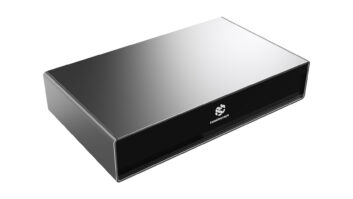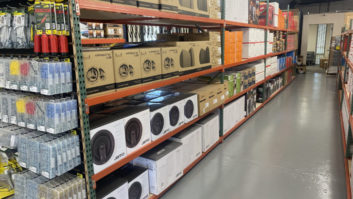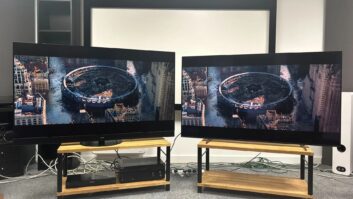Blu-ray has won the HD disc format battle and while still firmly behind plasma, LCD may get more attention. Those are just two of the opinions Joseph Taylor, executive VP/ COO of Panasonic Corporation of North America shared with TWICE during an exclusive interview since taking the job earlier this year.
Taylor is a 25-year company veteran who was most recently president/CEO of Panasonic Industrial Company. When he was named to his new post ( see TWICE, April 9, p. 1), Taylor was also appointed an executive officer of parent company Matsushita Electric Industrial. He is the first American to be appointed to that office.
Taylor was candid in addressing a wide variety of issues that are facing both Panasonic and the industry.
TWICE: How will we know and when will we know whether Blu-ray or HD DVD will have won the HD disc format battle?
Taylor: I’m going to give you a very politically incorrect answer. I think the battle is over. I think that Blu-ray has won. And you may say, “What’s the basis of that?” Well, some of so-called experts have already made that same comment. For me there are two determining factors: Who did the content providers select? At the moment, overwhelmingly, the content providers have selected Blu ray. What are consumers buying? Since the beginning of this year the content has almost been two to one for Blu-ray. There may be some noise for a little while, but in the end I think Blu-ray will be the technology that wins this battle.
TWICE: Is Panasonic comfortable being a major supplier of plasma TVs when LCD sales are growing rapidly?
Taylor: We are never comfortable and hope we never become comfortable. Really, the marketplace will decide which flat panel [format] they prefer. We are unique because we just don’t provide plasma but LCD. In this unique position we can do what our customers need us to do. What’s interesting is that as the market has changed in the three or four years since we introduced it. Clearly [plasma] is the leader in the large sizes, 42-inch and up. In fact our 50-inch has been outselling our 42-inch by about 20 percent since the beginning of this year. At the same time we recognize that LCD is taking a very strong position in the smaller sizes and market by market we will address that. And as the U.S. market develops we will introduce whatever technologies the consumers prefer.
TWICE: In the past couple of years in speaking with Panasonic all you would hear is “plasma, plasma, plasma” and some talk of Blu-ray. Is there any thought to expand the message in the U.S. to discuss Panasonic’s diverse product line?
Taylor: I think that if “plasma, plasma, plasma” is what you’ve heard we probably haven’t done a better job in reviewing our overall strategy. Plasma was always designed to be the centerpiece of the home, the centerpiece of what we call “living in high definition.” In the beginning plasma was intended to drive the growth and the sales of other digital products like high-definition camcorders, digital still cameras and Blu-ray, which all connect very easily to plasma. What’s changed is that we are not just plasma anymore. At least we are not just pushing plasma anymore. We are pushing all of those digital devices. And we are not just saying plasma we are saying flat panel because we are also a major manufacturer of LCD product as well.
TWICE: How does Panasonic view the second half in terms of sales and profitability?
Taylor: I can give you my hope, which is probably the same as everyone else’s. I don’t know what the second half will bring. My job as COO is that we hit our expectations, although I always say that hope is not a strategy. We have big plans for plasma. We expect Blu-ray to take off, and we have really strong initiatives with digital still cameras and high-definition camcorders that we think will also help us have a strong second half.
TWICE: How aggressive will flat-panel pricing be during this Holiday season? Will it be as bad as last year?
Taylor: There has been a discussion about how competitive plasma pricing is and that’s been true, but it is like it is the first time that this has happened in the CE business. I come from the industry side with the computer and telecommunications companies for 25 years. [In consumer electronics] we haven’t seen anything like the PC industry or the cellphone industry. We have to get used to the fact that consumers are driving demand. And consumers are the ones that determine pricing. Manufacturers and retailers don’t determine it. Yes, we would have all been happy if the market didn’t change at all and people would be happy to spend $5000 for a 42-inch TV. But the reality is that was never going to happen. I expect that demand would continue to drive prices. I expect that pressures will continue to be on all consumer electronics devices and not just plasma.
TWICE: How does the Chapter 11 filing of Tweeter and the financial fortunes of Circuit City, CompUSA and others reflect on the overall health of the industry?
Taylor: I don’t think it negatively impacts the overall consumer electronics industry. In consumer electronics, like any other industry, companies come and companies go, companies succeed and companies fail. And while it is unfortunate that some of these major players are suffering financially the entire industry is struggling at the moment, trying to become more competitive in this unbelievably competitive marketplace.
TWICE: How concerned are you that with more low-cost brands entering the market and lower profitability that there won’t be enough profit to invest in next generation technologies?
Taylor: That’s a great question. It is a question that not just faces consumer electronics but almost ever industry we look at. We are at a hyper-competitive marketplace, it is a global marketplace and the reality is that if you believe in the free market and capitalism companies will come and go, unless we are able to find ways to introduce new products, to invest in new technology, and to do it fast and quick at the lowest cost we won’t survive, nor would anyone else. That may be the single biggest question with the single biggest answer coming that will determine who survives and who fails. But it’s not a new question for this industry. We’ve all been faced with this for many years.
Check TWICE.com for a video of this exclusive one-on-one interview.













